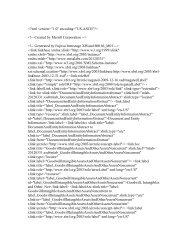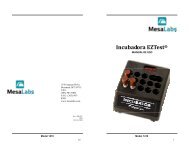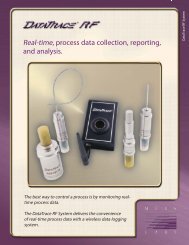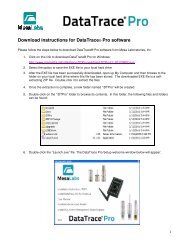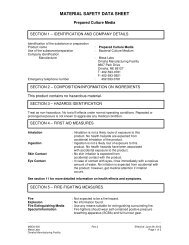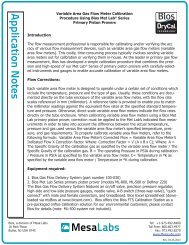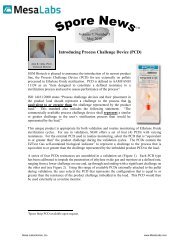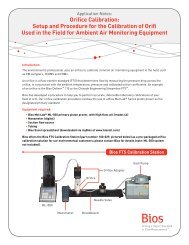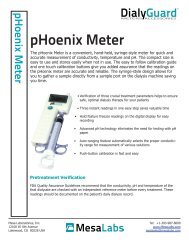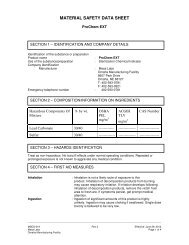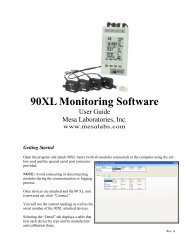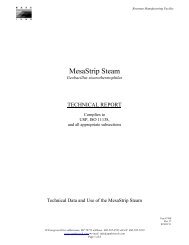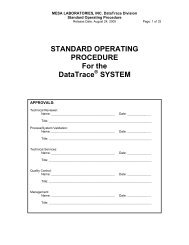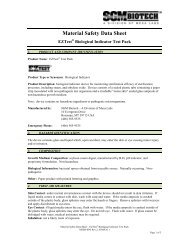Spore News V1 N5 John Consistent BI Require Clean ... - Mesa Labs
Spore News V1 N5 John Consistent BI Require Clean ... - Mesa Labs
Spore News V1 N5 John Consistent BI Require Clean ... - Mesa Labs
Create successful ePaper yourself
Turn your PDF publications into a flip-book with our unique Google optimized e-Paper software.
Volume 1, Number 5<br />
December 2004<br />
<strong>Consistent</strong> Biological Indicators <strong>Require</strong> <strong>Clean</strong> <strong>Spore</strong>s<br />
<strong>John</strong> R. Gillis, Ph.D.<br />
Inter and intra lot reproducibility of Biological Indicators (<strong>BI</strong>s) is<br />
enhanced by processing techniques to remove debris from spore<br />
suspensions prior to the production of <strong>BI</strong>s.<br />
INTRODUCTION:<br />
For more than 50 years, bacterial endospores have been<br />
used as biological indicators for monitoring sterilization<br />
processes. The microorganisms used are referenced in<br />
USP, ISO, and European Norms from well<br />
characterized type cultures such as ATCC (American<br />
Type Culture Collection). The reality is that some<br />
sources of biological indicators prepared from identical<br />
type cultures demonstrate a wide variation of sensitivity<br />
to sterilizing conditions as measured by D-values in<br />
<strong>BI</strong>ER vessels. This variability can be attributed to how<br />
the spores are grown and prepared.<br />
<strong>Clean</strong>ed G. stearothermophilus spores<br />
PREPARING <strong>BI</strong>s:<br />
It is important that the harvested spores from the bulk culture are free from nutrients and<br />
debris that can act as insulation or protection around individual spores. Cellular debris<br />
and residual media should be thoroughly removed from spore suspensions. When the<br />
spores are dried onto carriers this debris will dry around the spore and protect it from the<br />
sterilizing agent. The exact procedures used by <strong>BI</strong> manufacturers are proprietary and will<br />
vary. From the user’s perspective, the importance is not in the method used but its<br />
consistency. Consistency in <strong>BI</strong> performance should be the most important quality<br />
characteristic used by customers in selecting a <strong>BI</strong> supplier.<br />
<strong>Mesa</strong> Laboratories, Inc.<br />
www.<strong>Mesa</strong><strong>Labs</strong>.com
Before Processing<br />
After Processing<br />
D-values from 21 lots of <strong>BI</strong>s from SGM and another manufacturer appear in Table 1.<br />
Figure 1 illustrates a frequency distribution of SGM spore crop resistance over five years<br />
compared to a competitor’s product variation over two years. The carriers for both<br />
products are paper and the spores are G. stearothermophilusATCC 7953. The 21 lots of<br />
SGM product are sequential spore crops over the past five years. The competitor’s data<br />
progresses over approximately two years and the spore crops are identified by a<br />
sequential number system.<br />
Table 1<br />
SGM Biotech, Inc. Company 2<br />
Lot (1) D-value Lot (2) D-value<br />
BST-203P 2.0 1 1.1 (3)<br />
BST-208P 2.0 2 1.3 (3)<br />
BST-216P 2.0 3 1.2 (3)<br />
BST-221P 2.0 4 1.5<br />
BST-222P 2.0 5 2.3<br />
BST-232P 2.2 6 1.8<br />
BST-235P 2.3 7 1.5<br />
BST-239P 2.0 8 1.9<br />
BST-246P 2.3 9 1.9<br />
BST-251P 2.4 10 1.5<br />
BST-255P 1.9 11 1.9<br />
BST-256P 1.9 12 2.2<br />
BST-262P 2.0 13 1.5<br />
BST-273P 1.7 14 1.8<br />
BST-275P 2.0 15 2.4<br />
BST-279P 2.0 16 1.6<br />
BST-281P 2.0 17 1.5<br />
BST-284P 1.8 18 1.3 (3)<br />
BST-286P 1.7 19 1.0 (3)<br />
BST-288P 1.8 20 1.2 (3)<br />
BST-289P 2.1 21 0.7<br />
Average D-value 2.0 Average D-value 1.5<br />
Highest 2.4 Highest 2.4<br />
Lowest 1.7 Lowest 0.7<br />
1 Different lot numbers relate to different spore crops. Gaps in the lot number sequence indicate that<br />
the same spore crop was used.<br />
2 Actual lot numbers are unknown. Therefore, a sequential numbering system is used.<br />
3 Values below the ISO 11138-3 minimum acceptable value of 1.5 minutes.<br />
<strong>Mesa</strong> Laboratories, Inc.<br />
www.<strong>Mesa</strong><strong>Labs</strong>.com
Figure 1 illustrates a frequency distribution plot of the 21 SGM <strong>BI</strong> lots. Figure 2<br />
illustrates a frequency distribution plot for Company 2 D-value data.<br />
D-value Distribution Comparison<br />
0.5<br />
SGM<br />
0.5<br />
COMPANY 2<br />
Relative Frequency<br />
0.4<br />
0.3<br />
0.2<br />
0.1<br />
Relative Frequency<br />
0.4<br />
0.3<br />
0.2<br />
0.1<br />
0.0<br />
0.5 1.0 1.5 2.0 2.5<br />
D 121 -value<br />
0.0<br />
0.5 1.0 1.5 2.0 2.5<br />
D 121 -value<br />
Figure 1 Figure 2<br />
Statistics<br />
Minimum<br />
Maximum<br />
Mean<br />
Std. Deviation<br />
Std. Error<br />
Lower 95% CI of mean<br />
Upper 95% CI of mean<br />
Coefficient of variation<br />
SGM<br />
1.70<br />
2.40<br />
2.00<br />
0.183<br />
0.0399<br />
1.92<br />
2.09<br />
9.13%<br />
Co. 2<br />
0.700<br />
2.40<br />
1.58<br />
0.436<br />
0.0951<br />
1.38<br />
1.77<br />
27.65%<br />
D-values:<br />
In this specific case, the <strong>BI</strong>s consist of G. stearothermophilus for steam sterilization; the<br />
ISO 11138 and EN 866 require a minimum D-value at 121°C of 1.5 minutes.<br />
Company 1 - SGM Biotech, Inc.<br />
The SGM data provided indicates an average D-value of 2.0 minutes. This represents a<br />
normal thermal resistance of many different spore crops grown under similar conditions.<br />
SGM D-values ranged from 1.7 to 2.4 minutes, which is equal to + 20% above the<br />
average and -15% below the average.<br />
Company 2<br />
The data accumulated indicates an average D-value of 1.5 minutes. The competing<br />
product D-values ranged from 0.7 to 2.4 minutes, which is equal to +60% above the<br />
average and -46% below the average. There are seven D-values actually falling below<br />
the minimum 1.5 minutes required by USP and EN.<br />
<strong>Mesa</strong> Laboratories, Inc.<br />
www.<strong>Mesa</strong><strong>Labs</strong>.com
SPORES ARE PREDICTABLE:<br />
Biological indicators for validation and monitoring sterilization processes constitute a test<br />
method which to be useful needs to demonstrate a measure of reproducibility. Because<br />
of the biological nature of spores, there will be some inherent variation in their survival<br />
characteristics, depending on individual differences. But normal response variation of<br />
spores should not be sufficient to cause any concern or interlot unacceptability for<br />
sterilization monitoring purposes.<br />
EXPLAINING UNACCEPTABLE D-VALUES:<br />
Manufacturers use different media and techniques for culturing spore forming bacteria as<br />
well as different techniques for harvesting and handling spore suspensions. It is in these<br />
techniques that factors are introduced which can either raise or reduce D-values. Over a<br />
period of five years the SGM lots consistently gave D-value results close to 2.0 minutes.<br />
The lowest D-value was 1.7 minutes and still within requirements of the standards. The<br />
second manufacturer’s data as listed in Table 1, show seven results are below the ISO and<br />
EN requirements for use as a <strong>BI</strong> and the range of D-values is much wider.<br />
Variable cultural conditions and extraneous cellular debris would tend to influence<br />
thermal resistance of spores. Well controlled laboratory SOPs and materials aid in<br />
maintaining the highest quality standards and reduce inter and intralot variability.<br />
CONCLUSIONS:<br />
Biological indicators based on bacterial spores provide a proven, reliable validation tool<br />
for sterilization processes. <strong>BI</strong>s are unique as a single test that challenges all of the<br />
critical parameters of sterilization processes.<br />
But from a user’s perspective, major differences between lots as expressed by D-values<br />
are frustrating and can be avoided. SGM will make available, upon request, all of the<br />
release data of purchased product.<br />
It would be unreasonable to expect every lot to have a D-value of exactly 2.0 minutes<br />
because of the limitations of the test procedure and the nature of biologicals. But a range<br />
of 1.7 to 2.4 minutes is a reasonable expectation.<br />
Please email us with topics you would like to see addressed in “<strong>Spore</strong> <strong>News</strong>”.<br />
<strong>Mesa</strong> Laboratories, Inc.<br />
www.<strong>Mesa</strong><strong>Labs</strong>.com



